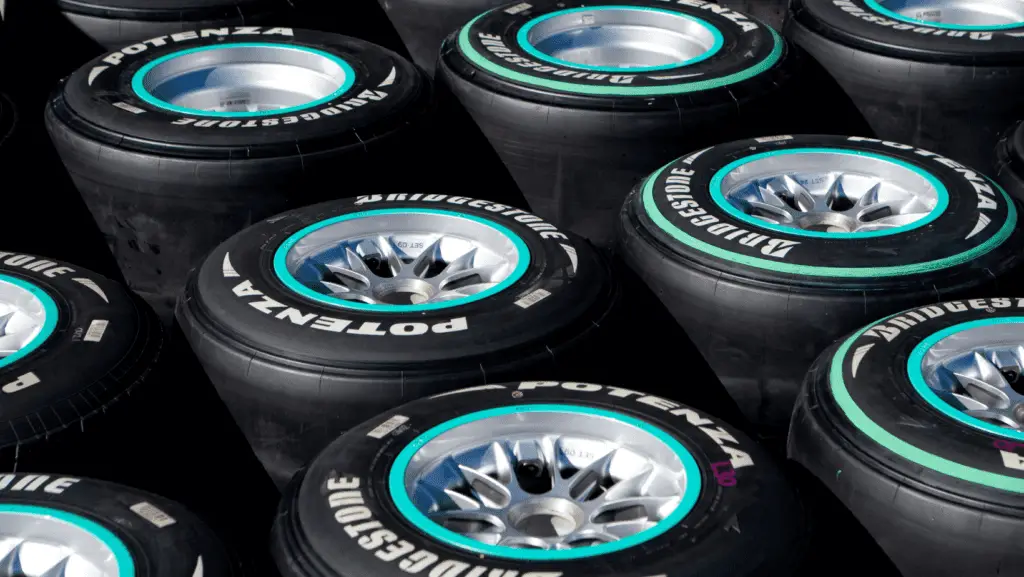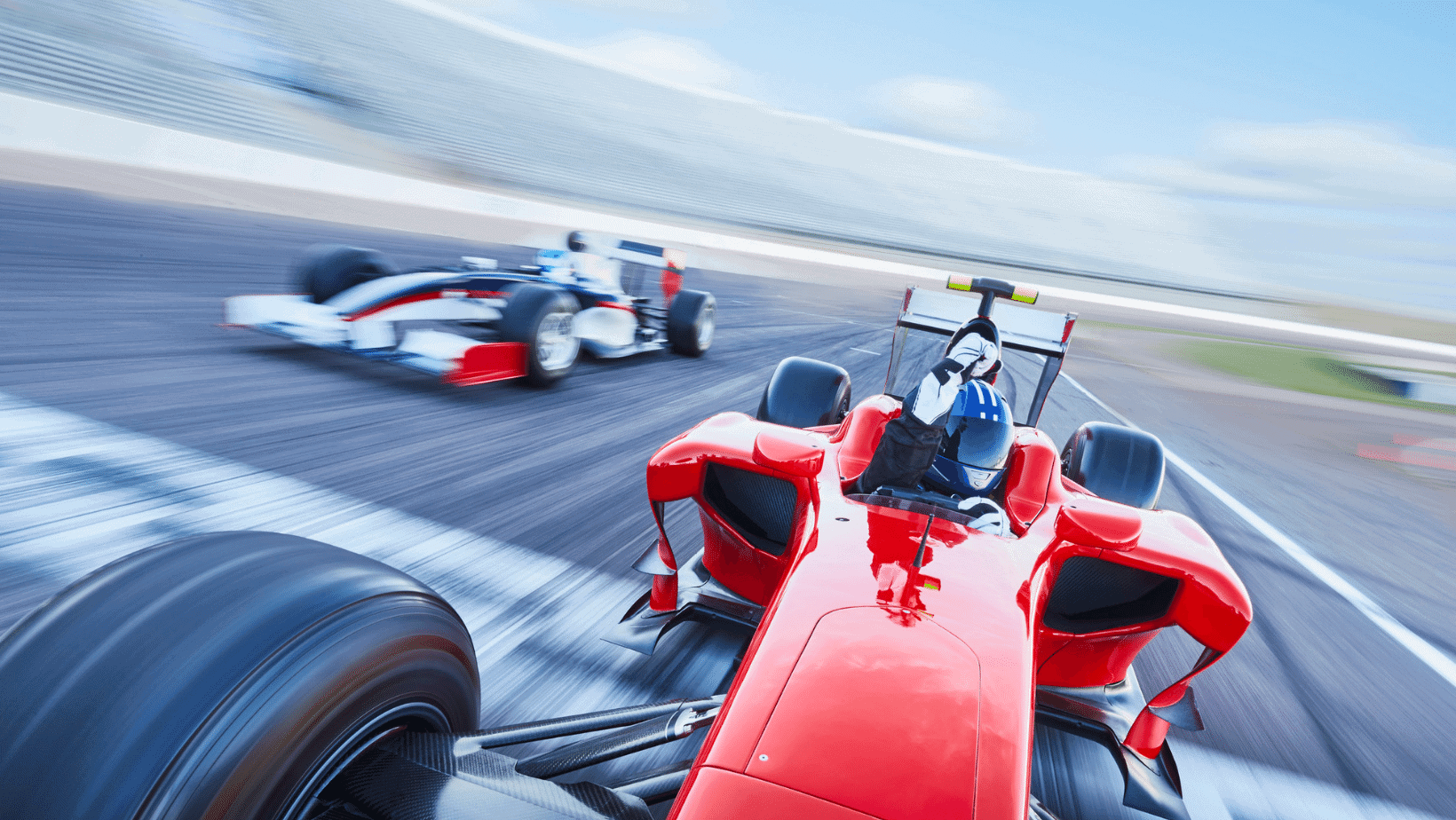Everything related to Formula 1 is generally considered synonymous with perfection.
The speed, precision, and finesse of F1 cars demand innovation and set the standards for other vehicle designers to follow.
The tires, however, are a different story. F1 car tires are not designed for the roads, because they prefer performance over longevity.
Here’s everything you need to know about the types of F1 tires and how different they are from their on-road counterparts.
An Overview of F1 Tires
Formula 1 tires are among the most important design considerations for any race car because it’s the only part that remains in contact with the ground during high-speed performances.
Unlike the regular tires, you or I deal with, the main decision isn’t based on simply summer or winter tires.
F1 tires are of various kinds depending on the compound, design, aerodynamic profile, and most importantly the operating range.
One more thing that makes F1 tires different is their performance standards.
On-road tires that focus on performance over longevity still give you a lifespan of at least 15000 miles.
On the other hand, F1 tires will probably last you a maximum of 100 miles because the main aim of the designers is to make something as light and strong as possible.
Despite the shorter lifespans, F1 tires are extremely complex.
The inner Kevlar linings, nylon structures, weave patterns, and all the other factors combine to give these tires the ability to withstand the massive forces of acceleration and deceleration on the road.
When you consider all the forces and deformations a regular tire goes through, you’ll agree that the tires are nothing shorter than an engineering marvel.
Today, the tire company Pirelli is responsible for F1 tires. However, Bridgestone used to have this responsibility in the past.
Why Are There Different Kinds of F1 Tires?
If you are a beginner in the world of F1, you might wonder what’s the point of having different types of F1 tires?
F1 tires will be different than on-road ones but further classifications of tires within the F1 category is something difficult to comprehend.
In the shortest term, the main reason behind this is strategy.
The type of track, the distance you are targeting, and the optimum temperature of the compound you are using are some of the most important factors F1 teams consider before deciding on a tire.
The first thing the combination of compounds affects is the overall temperature of the tires. It needs to be in the optimal range.
If the temperature is too high, the tires would start degrading quickly with pieces of rubber falling off prematurely.
Contrarily, lower temperatures cause the tire to develop grains that can expedite the degradation again.
Types of Tire Compounds
F1 tires are characterized as dry or wet tires. Those dry and wet tires are then further divided according to the dominant compound.
The main thing your choice of compound effects is the overall hardness, which then further affects the other performance parameters of the tire.
Dry Compounds
These compounds are numbered from 1 to 5 with 1 being the hardest and 5 being the softest.
Apart from that, the compound also affects the overall heat resistance of the tire and delivers an overall better consistency during the operational lifespan of the tire.
Here are the details of what each compound brings to the table.
C1
C1 or Compound 1 is the hardest specification for any F1 tires.
It’s suitable for tracks with a lot of abrasive properties and can sustain the largest loads with consistency across the board.
Generally, strategists choose C1 tires for races with a lot of sharp corners and longer laps.
The abrasive resistance of the tires gives them better longevity through reduced degradation during use.
Another important thing to note about these tires is the fact that compound 1 tires take a very long time to warm up.
The material also resists graining, which effectively stops the degradation process at lower temperatures.
You can easily recognize compound 1 tires through a white-colored band on the tire’s wall.
C2
They are the ideal choice for tracks with a lot of corners and energy requirements but minimal abrasions on the ground.
Just like the C1 tires, these tires also perform really well at longer laps because they are built to withstand a plethora of forces due to direct contact from the ground.
These tires also have a versatile working range and come with impressive adaptability. You can recognize them through an off-white or yellow banding around the wall.
C3
The compound 3 tire has the best balance of all the important parameters that determine the performance and durability of the tire.
The tire is considered soft and doesn’t work well on high-severity tracks.
While the C3 tire is considered durable, it isn’t when you compare it with its C1 or C2 counterparts.
You can recognize C3 tires through their white, yellow, or red branding.
As these colors are used in other compounds as well, working on them becomes difficult.
C4
The compound 4 tires lean more towards speed and control. It’s very close to the popular ultrasoft tires that work extremely well on twisty circuits.
These tires deliver exceptional control and better overall consistency when it comes to heat distribution.
However, C4 tires tend to warm up fast and have a limited overall lifespan. That’s why they are more suitable for circuits with a shorter lap and smoother surface.
C5
The Compound 5 or C5 tire is the softest variant of F1 tires that comes with exceptional speed characteristics and incredible control.
That’s why they are the natural choice for circuits where the tracks demand exceptional grip and control.
Naturally, there is a trade-off because of the exceptional performance this compound offers. That trade-off is the lifespan, which is considerably shorter.
The C5 tire will only have a red banding on its tire wall and will be distinctively discernable because of its smooth and shiny texture.
Wet Compounds
Wet tires are designed to provide the same level of control and performance standards as the aforementioned tires.
However, they come with an additional capability to dispel or evacuate water and resist aquaplaning, which is when the tire loses its grip due to the rain.
Today, there are two options in the wet category for F1 tires.
Light Blue
The light blue or blue tire is the most obvious choice for heavy rain and wet tracks.
It provides exceptional control levels and can expel around 85 liters of water per second at the speed of 190 miles per hour.
Blue tires also come with an additional feature of resisting aquaplaning, which allows the tires to maintain a grip under heavy rain and provide exceptional control.
Green
The green is not a 100% wet tire as it provides a perfect balance between the two.
You can’t use it during heavy rain or on tracks with standing water.
However, they are excellent on wet or drying tracks along with slick tracks which expands their working range and make them an ideal choice for a lot of scenarios.
When it comes to water expulsion, green tires offer a rate of 30 liters per second at 190 miles per hour, which is not as good as the blue counterpart, but still allows the tire to perform as expected.
Some Other Colors You Must Know About

When it comes to F1 tires, the color on the tire wall can give you a lot of information.
Apart from the regular white, yellow, red, and others, you might encounter the following colors in the F1 circuit.
Ultra – Soft – Purple
The purple branding means that you have the softest tire available in the F1 category. This is the fastest tire in the category and is only allowed on the street circuit.
Supersoft – red
This too is a soft variant capable of delivering excellent performance in twisty, but shorter laps.
The supersoft tires also deliver an excellent mechanical grip in colder weather because of their rapid warm-up time.
However, that means faster degradation and a shorter lifespan.
Soft – yellow
This is a balanced option that delivers you the best of both worlds with decent performance and durability.
This tire still leans towards speed more but nevertheless delivers durability as well.
Generally, strategists either use this at the start of the race for a head start or in the final laps to ensure the maximum chance of winning.
Medium – white
This is a versatile option that remains perfect for all dry conditions because it also delivers the perfect balance between durability and performance.
Contrary to the yellow tire, this one leans a bit more towards durability but delivers excellent speed as well.
Hard – Ice Blue
Blue means wet in the F1 circuit. This is the ideal tire for rainy conditions as it expels water quickly and resists aquaplaning.
Super Hard – orange
Finally, this is the most durable tire choice in the F1 category because of its hardness.
These tires have a high energy loading capacity to sustain damage from abrasion and rough surfaces.
Moreover, orange tires also take a long time to warm up, which slows down degradation and allows you to run longer laps.
Generally, strategists use these tires in the middle of the race to avoid multiple pit stops or when they have to run long laps on harsher surfaces.
The Fastest Tires in the F1 Category
There are several considerations before a verdict but the general rule of thumb is that the softer your tire is, the faster it will be.
With that logic, C5 or compound 5 tires will be the fastest in the F1 category.
With that said, you might wonder why don’t all teams and strategists simply use softer tires like C5 or C4 throughout the race.
They do make pit stops and can simply replace the worn-out tires sooner to ensure that things remain operational.
However, that’s not possible.
Even if we ignore the fact that frequent pit stops will simply waste more time overall, you need to consider the rules as well.
F1 rules allow only a limited number of dry tire sets in one race. So, strategists need to consider all that while selecting the types of F1 tires they’ll be using.
Tire Sizes in F1 Cars
Since the sport is so rigid, it’s natural to assume that they’ll have a rule in place regarding the tire size.
Today, the standard size is a 13-inch wheel that the whole industry uses in races to ensure that no team has an unfair advantage.
Larger wheel sizes can allow better, more powerful brakes, which means that drivers can easily overtake others during braking zones.
Having a standardized size prevents that and allows in the sport.
Final Thoughts
F1 tires are extremely complicated because of their advanced speed and performance requirements.
The current rules allow strategists and race teams to use innovation and the right combination of compounds to create the best lineup that ensures the best speed, durability, and control on the road.
This text took a slight look at the types of tires in F1 circuits and discussed a few things beginners should know before taking more interest in the intricacies of the sport.


